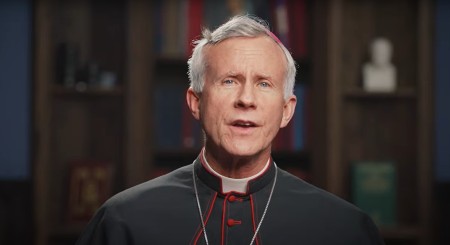 Dear readers, Catholic Online was de-platformed by Shopify for our pro-life beliefs. They shut down our Catholic Online, Catholic Online School, Prayer Candles, and Catholic Online Learning Resources—essential faith tools serving over 1.4 million students and millions of families worldwide. Our founders, now in their 70's, just gave their entire life savings to protect this mission. But fewer than 2% of readers donate. If everyone gave just $5, the cost of a coffee, we could rebuild stronger and keep Catholic education free for all. Stand with us in faith. Thank you. Help Now >
Dear readers, Catholic Online was de-platformed by Shopify for our pro-life beliefs. They shut down our Catholic Online, Catholic Online School, Prayer Candles, and Catholic Online Learning Resources—essential faith tools serving over 1.4 million students and millions of families worldwide. Our founders, now in their 70's, just gave their entire life savings to protect this mission. But fewer than 2% of readers donate. If everyone gave just $5, the cost of a coffee, we could rebuild stronger and keep Catholic education free for all. Stand with us in faith. Thank you. Help Now >
Relationships and the Social Doctrine: The Gospel of the 'Is With'
FREE Catholic Classes
Highlights
Catholic Online (https://www.catholic.org)
10/21/2011 (1 decade ago)
Published in Living Faith
Keywords: social doctrine, love, solidarity, human rights, civil rights, compendium, social justice, Andrew Greenwell, Esq.
CORPUS CHRISTI, TX (Catholic Online) - Two things there are from which the Church can never separate: Jesus Christ and mankind. Christ is head of the Church. Christ is the bridegroom, the Church his bride, the two bound in an eternal marriage. The Spirit of Christ is the Church's spiritual soul. Christ-body, soul, flesh, and divinity-is the meat of her spiritual and supersubstantial food, the Eucharist. And Christ is the chief subject, the centerpiece, of her universal message of the salvation proffered to all men in Christ by a merciful God.
Christ's universality, then, binds the Church to all mankind, of which she is also part. There is not one man, woman, or child which she would ban from her message, or for whom the message would be irrelevant or superfluous. Like the colonnades of Bernini at St. Peter's square which seem to reach out and embrace all mankind, Christ's love, which the Bernini colonnades symbolize, embraces all bar none. It is for this reason that the Church "continues to speak to all people and all nations," and always will. (Compendium, No. 1)
Now the Lord Jesus did not come only to save spiritual souls, to pull them out of the shells of their bodies and leave the body behind like refuse, as if the Gospel were nothing more than emptying out the contents of a disposable can. No. Our Lord came to save every man, woman, and child in his or her integrity: soul and body. That is why the doctrine of the Resurrection of the body has always been central to the Christian message. This, of course, is the anchoring truth of John Paul II's "theology of the body."
But Jesus and his Gospel go beyond even this. Every human being is more than soul and body. Every human being is fitted within relations: is someone's son or daughter, is perhaps someone's father or mother, is the member of some tribe, the member of some group, or the citizen of some nation. Every human being rubs shoulders with, exchanges words with, trades goods and services with, works with, breaks bread with, consorts with, and sometimes even fights with others of his kind. Every human being is answerable to law, civil, religious, and natural, laws to which he is held accountable, sometimes even with his life. Every person not only is, but also is with others.
Again, Christ came not only to save spiritual souls and fleshly bodies: He came also to save relations. He came to save both the is of each of us and the is with of each of us. Relations among men, the is with, ought to be governed by justice and ought to conduce to peace. Like Christ, the Church therefore addresses her Gospel to all humans and all human reality: the is and the is with. That part of the Gospel that addresses the is with of each of our lives is the Church's social doctrine.
The Gospel addresses itself first to the is, and from the is it spills over to the is with:
"Discovering that they are loved by God, people come to understand their own transcendent dignity, they learn not to be satisfied with only themselves [the "is"] but to encounter in their neighbor in a network of relationships that are ever more authentically human [the "is with"]. Men and women [the "is"] who are made "new" by the love of God are able to change the rules and quality of relationships, transforming even social structures [the "is with"]. (Compendium, No. 4)
Love is what changes the is, and love moves from changing the is to changing the entire is with so that the entire world of is with also conforms to love.
Love is necessarily ebullient: it cannot be bottled up in a Coke bottle and sold by the fluid ounce. It cannot be stored in a safe, kept on deposit for a later day. It cannot be divided up and parceled out, as if it were a welfare dole, and therein remain satisfied. Love is no respecter of boundaries, and it does not limit itself to the is.
No, love is something like the five loaves of bread and the two fish that Jesus blessed, and then inexplicably fed a crowd of thousands, with plenty left over to spare after the thousands had their fill. Cf. Luke 9:12-17. It never stays water; it always changes into wine. It spills over almost recklessly, but never lawlessly, into the is with. It always, invariably will focus on the Other.
And so the Church's message of God's love, including her social doctrine, is not to be kept in any storehouse like the wealth of a rich man, or under a bushel basket such as one may foolishly put a candle.
The Church's social doctrine is something like a Mother Theresa of Calcutta or a Father Damien: especially while others suffer, it will not stay trapped in a convent in solitary contemplation or remain only a vacuous word, but it will clamber over walls, break through the gates, cross oceans and deserts, face the swords and rifles of power, if it has to, and venture into the rough-and-tumble-and-dirty streets of Calcutta or the leprosorium of the island of Molokai, and engage in action, even, at times, to unpopular denunciation.
"Christian love leads to denunciation, proposals and a commitment to cultural and social projects; it prompts positive activity that inspires all who sincerely have the good of man at heart to make their contribution." (Compendium, No. 6)
Urged by love, we are both Marthas and Marys. We live in a world of both theory and practice, of being and doing, and the Church's social teaching comprehends both.
Nothing is worse than a talker and not a doer, except a doer who does not know what he is about. In fact, the bane of society is the social gadfly, the officious intermeddler, an activist without guidance, or worse, an activist guided by bad ideas. Nothing is worse than someone who wants to change the is with who has not changed the is. Nothing is worse than someone who wants to change the is with when he does not know what the is with ought to be. And so the social doctrine of the Church provides guidance for action by informing us what the is with ought to be.
"[I]n the social doctrine of the Church can be found the principles for reflection, the criteria for judgment, and the directives for action which are the starting point for the promotion of an integral and solidary humanism. Making this doctrine known constitutes, therefore, a genuine pastoral priority, so that men and women will be enlightened by it and will be thus enable to interpret today's reality and seek appropriate paths of action." (Compendium, No. 7)
It this felt urgency that drove the Pontifical Council for Justice and Peace to put together the Compendium of the Social Doctrine of the Church. It purports to provide a "complete overview of the fundamental framework of the doctrinal corpus of Catholic social teaching." And this complete overview, which must be taken in its complete integrity, is calculated to "suggest a systematic approach for finding solutions to problems, so that discernment, judgment, and decisions will correspond to reality." It is meant "as a guide to inspire, at the individual and collective levels, attitudes and choices that will permit all people to look at the future with greater trust and hope." It is meant as an "aid for the faithful concerning the Church's teaching in the area of social morality." (Compendium, No. 10)
Clearly, it has a lot of functional uses.
For those, then, that confront the felt injustices of the world and her structures and institutions, for those who believe that they are their brother's keeper and want to extend a helping hand, for those who want to fix not only the is, but also the is with, for those who want to avoid being officious intermeddlers and mere social gadflies who do more harm than good, the Compendium is a necessary resource.
It is, in fact, a vade mecum that ought to be in the hand of every bishop, every priest, every religious, and every lay person in the Church. Indeed, it ought to find itself in the hands of our separated brothers and sisters in Christ, in the hands of those of other faiths, and in the hands of all men and women of good will. Its message is that universal, that non-sectarian. It comes with the same impetus, the same hope as the coming of Christ, of whom it bears witness: "Glory to God in the highest, and on earth peace to men of good will." Luke 2:14.
"By means of the present document [the Compendium], the Church intends to offer a contribution of truth to the question of man's place in nature and in human society, a question faced by civilizations and cultures in which expressions of human wisdom are found . . . . The direction that human existence, society, and history will take depends largely on the answers given to the questions of man's place in nature and society; the purpose of the present document is to make a contribution to these answers. . . . The Church . . . intends with this document on her social doctrine to propose to all men and women a humanism that is up to the standards of God's plan of love in history, an integral and solidary humanism capable of creating a new social, economic, and political order founded on the dignity and freedom of every human person, to be brought about in peace, justice, and solidarity." (Compendium, No. 14-15, 19)
To summarize: the Compendium is the guide to the is with in all our lives. It is a sure charter to those who feel that they are their brother's keeper, the brother who always is with them, whether in his mother's womb, or on a hospice death bed, or anywhere in between. It is, in fact, a compendium or exposition of the second table of the Ten Commandments, which Christ encapsulated in that Golden Rule: you shall love your neighbor as yourself. Cf. Luke 10:26; Mark 12:31.
How can we do without it?
-----
Andrew M. Greenwell is an attorney licensed to practice law in Texas, practicing in Corpus Christi, Texas. He is married with three children. He maintains a blog entirely devoted to the natural law, called Lex Christianorum. You can contact Andrew at agreenwell@harris-greenwell.com.
---
'Help Give every Student and Teacher FREE resources for a world-class Moral Catholic Education'
Copyright 2021 - Distributed by Catholic Online
Join the Movement
When you sign up below, you don't just join an email list - you're joining an entire movement for Free world class Catholic education.
-

-
Mysteries of the Rosary
-
St. Faustina Kowalska
-
Litany of the Blessed Virgin Mary
-
Saint of the Day for Wednesday, Oct 4th, 2023
-
Popular Saints
-
St. Francis of Assisi
-
Bible
-
Female / Women Saints
-
7 Morning Prayers you need to get your day started with God
-
Litany of the Blessed Virgin Mary
5 Biblical Warnings We All Must Heed
-

WHAT WILL IT TAKE? | Bishop Strickland Calls Out Silent Bishops in Strong Public Letter
-

Giants of the Fallen: Unveiling the Mystery of the Nephilim from a Catholic Perspective
-
Ancient Wisdom, Modern Choices: How Ecclesiastes 10:2 Illuminates Today's Political Divide
-
How Do We Know Truth? A Catholic Perspective
Daily Catholic
 Daily Readings for Sunday, November 17, 2024
Daily Readings for Sunday, November 17, 2024 St. Elizabeth of Hungary: Saint of the Day for Sunday, November 17, 2024
St. Elizabeth of Hungary: Saint of the Day for Sunday, November 17, 2024 Prayer to Saint Anthony of Padua, Performer of Miracles: Prayer of the Day for Sunday, November 17, 2024
Prayer to Saint Anthony of Padua, Performer of Miracles: Prayer of the Day for Sunday, November 17, 2024- Daily Readings for Saturday, November 16, 2024
- St. Hugh of Lincoln: Saint of the Day for Sunday, November 17, 2024
- Prayer for Life: Prayer of the Day for Saturday, November 16, 2024
![]()
Copyright 2024 Catholic Online. All materials contained on this site, whether written, audible or visual are the exclusive property of Catholic Online and are protected under U.S. and International copyright laws, © Copyright 2024 Catholic Online. Any unauthorized use, without prior written consent of Catholic Online is strictly forbidden and prohibited.
Catholic Online is a Project of Your Catholic Voice Foundation, a Not-for-Profit Corporation. Your Catholic Voice Foundation has been granted a recognition of tax exemption under Section 501(c)(3) of the Internal Revenue Code. Federal Tax Identification Number: 81-0596847. Your gift is tax-deductible as allowed by law.









 Daily Readings for Sunday, November 17, 2024
Daily Readings for Sunday, November 17, 2024 St. Elizabeth of Hungary: Saint of the Day for Sunday, November 17, 2024
St. Elizabeth of Hungary: Saint of the Day for Sunday, November 17, 2024 Prayer to Saint Anthony of Padua, Performer of Miracles: Prayer of the Day for Sunday, November 17, 2024
Prayer to Saint Anthony of Padua, Performer of Miracles: Prayer of the Day for Sunday, November 17, 2024

